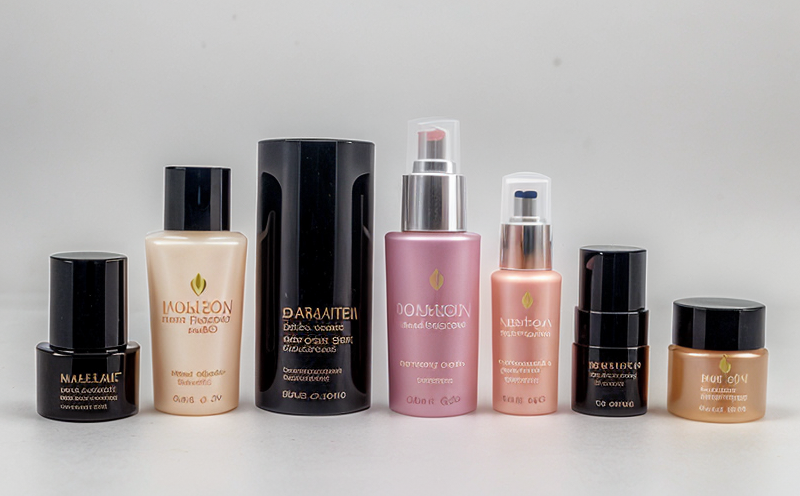Antioxidant Migration Testing in Cosmetic Containers
The testing of antioxidants within cosmetic containers is a critical aspect of ensuring product safety and compliance with international standards. Antioxidants are essential components used to prevent oxidative degradation, which can lead to quality loss, instability, and potentially harmful by-products in cosmetic products. This service focuses specifically on the migration of antioxidants from container materials into the cosmetic content itself, particularly under conditions that mimic real-world storage and usage.
Antioxidant migration testing is conducted according to stringent guidelines such as ISO 15079-2:2004(E) for plastic containers and ASTM F2338-16 for metal containers. The process involves placing the cosmetic product containing antioxidants into a container, simulating storage conditions over time, and then extracting and analyzing the contents for any signs of antioxidant migration.
The primary goal is to ensure that the level of antioxidants migrating from the packaging does not exceed safe limits set by regulatory bodies like the European Commission’s Cosmetics Regulation (EC 1223/2009) or the US Food and Drug Administration (FDA). This testing helps manufacturers meet these stringent safety requirements while maintaining product integrity.
The process begins with careful selection of test specimens, which are prepared in a manner that replicates real-world conditions. The containers used for migration testing must be representative of those that will be in contact with the cosmetic products during distribution and use. Specimens are filled with the specified cosmetic content and then stored under controlled temperature and humidity levels to simulate typical shelf-life exposure.
After the prescribed period, samples are extracted using appropriate solvents or methods defined by relevant standards. These extracts are analyzed for antioxidant presence via various analytical techniques such as high-performance liquid chromatography (HPLC) or gas chromatography-mass spectrometry (GC-MS). The results provide quantitative data on the amount of antioxidants that have migrated into the cosmetic product.
The importance of this testing cannot be overstated. By ensuring that there is no excessive migration, manufacturers can protect consumers from potential health risks associated with high levels of antioxidants in their products. This service plays a crucial role in maintaining consumer trust and compliance with international safety standards.
Why It Matters
The significance of antioxidant migration testing extends beyond mere regulatory compliance; it directly impacts product quality, safety, and consumer confidence. Regulatory bodies worldwide have established strict limits on the amount of antioxidants that can migrate from packaging into cosmetic products to prevent any adverse effects on health. Failure to adhere to these standards could result in recalls or legal action.
From a manufacturing perspective, ensuring that antioxidants do not migrate excessively involves meticulous control over raw material selection, container design, and production processes. This includes using appropriate barrier materials, optimizing packaging design for minimal exposure to external environmental factors, and implementing robust quality assurance measures throughout the supply chain.
For consumers, this testing ensures they are using products that remain stable and effective as intended. Excessive migration can lead to premature degradation of product efficacy, which may compromise its therapeutic or cosmetic benefits. By adhering to rigorous testing protocols, manufacturers demonstrate their commitment to delivering high-quality, safe, and reliable cosmetics.
In summary, antioxidant migration testing is not just a compliance exercise but a proactive approach towards enhancing product quality and safety. It underscores the importance of maintaining stringent control over every aspect of the manufacturing process, from raw material selection to final packaging.
Industry Applications
The application of antioxidant migration testing spans various sectors within the cosmetics industry, including skincare, haircare, makeup, and fragrance products. This service is particularly relevant for companies producing high-value, long-lasting formulations that rely heavily on antioxidants to preserve their active ingredients.
In the sector of personal care products, manufacturers must ensure that any antioxidants used do not migrate into the product at levels that could compromise its efficacy or stability. For instance, vitamin C-based serums and antioxidants like ferulic acid require careful management to prevent degradation upon contact with packaging materials.
For pharmaceutical cosmeceuticals, where the integrity of active ingredients is paramount, this testing ensures that formulations remain potent throughout their shelf life. Similarly, in the realm of specialty makeup products, such as long-wear foundations and mascaras, antioxidant migration can affect both the product's performance and user experience.
The industry applications are broad, but all share a common goal: to ensure that packaging does not negatively impact the quality or safety of cosmetic products. By leveraging this service, manufacturers can confidently meet regulatory requirements while upholding high standards of product excellence.
Use Cases and Application Examples
- Vitamin C Serums: Testing for antioxidant migration is crucial in ensuring that the efficacy of vitamin C remains intact during extended storage periods.
- Ferulic Acid Formulations: This antioxidant, when combined with other active ingredients, requires careful packaging to prevent degradation.
- Long-Wear Makeup Products: Ensuring that antioxidants do not migrate into the product can enhance the longevity and effectiveness of these makeup formulations.
- Pigmented Lipsticks: Antioxidants in lipstick can help maintain color intensity and protect against environmental factors like UV rays.
- Hair Care Products: Shampoos, conditioners, and styling products containing antioxidants need to be protected from migration to preserve their benefits.
- Fragrance Bottles: Glass or plastic bottles used for fragrances must be tested for antioxidant migration to maintain the integrity of the scent.
- Sunscreen Containers: The packaging of sunscreens should be designed and tested to prevent migration that could compromise SPF effectiveness.
- Cosmetics with Multiple Ingredients: Products containing a combination of antioxidants require comprehensive testing to ensure none migrate excessively into the product.





